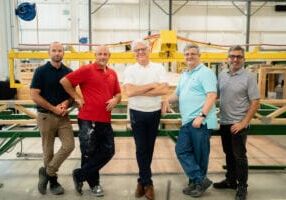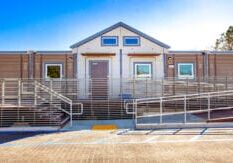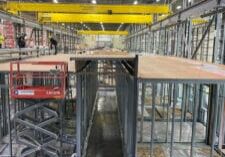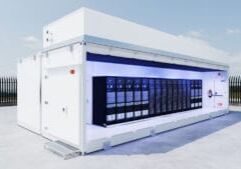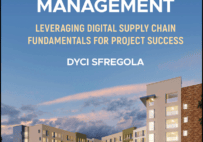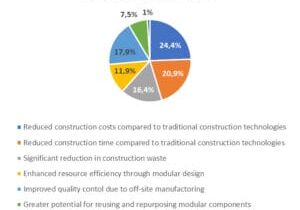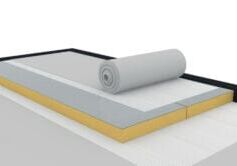Opportunities for Innovation

Colby Swanson is a Partner at Momentum Innovation Group and an Executive In Residence at ADL Ventures.
Innovation exists to positively change the status quo, drive progress, and create new value - something the construction industry desperately needs. Our industry faces a critical juncture, grappling with a shortage of skilled labor, stagnant productivity, escalating costs, and inconsistent quality. The complexity of challenges requires convergent collaboration - across disciplines (engineering, architecture, material science, finance, supply chain, etc.) and across sectors (construction, manufacturing) - where entrepreneurial agility is coupled with deep technical expertise and executive business savvy to propel construction innovation to new heights. We must look beyond traditional practices and embrace innovation inspired by industrialized construction (“IC”).
The often cited 2019 McKinsey report, Modular construction: From Projects to Products, succinctly states that a shift from traditional site-based construction (projects) to offsite prefabrication (products), when designed correctly, could provide up to a 12 percent improvement in productivity and reshape the construction supply and value chain as we know it. The reality is more nuanced so I have restated their “From projects to product” moniker to “From projects to building systems and processes”. The difference being a broader definition of “product” to include both a building system (of components) plus wrap-around processes which enable configurability, repeatability and scale.
The construction industry, often seen as resistant to change, is ripe for a revolution. The shift towards “building systems and processes” isn’t merely theoretical; it’s already taking shape in remarkable ways. From 3D-printed houses that rise in days (100 home subdivision 3D printed homes by ICON and Lennar) to modular skyscrapers that assemble like LEGOs (461 Dean St in Brooklyn consists of 32 modular stories, designed by SHoP Architects), the future of construction is unfolding before our eyes. But what does this mean for the average project? How can these innovations impact the way we design, build, and live in our spaces?
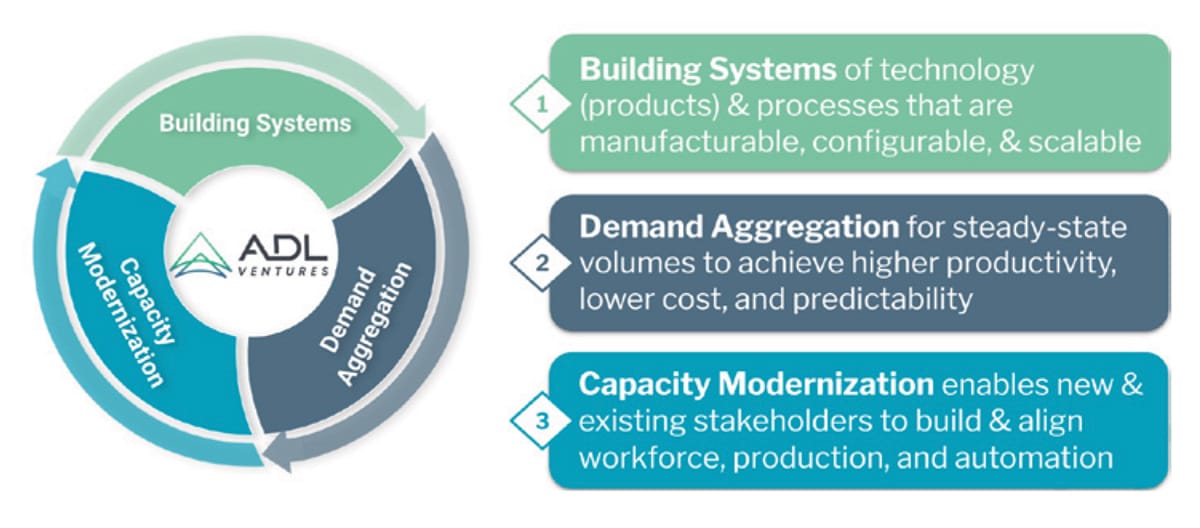
Theory of Change. Image courtesy ADL Ventures.
When considering where to innovate in the growing IC space, it helps to have a clear theory of change (“ToC”) to provide a focused roadmap of how change is expected to happen. ADL Ventures, a venture development firm who has spun-out eight companies, uses ToCs to guide decisions on where innovation has the highest potential for impact and success. There is another article to unpack in this ToC, but the core definition of each intervention is described in order of priority in the image as 1) Building Systems, 2) Demand Aggregation, and 3) Capacity Modernization.
In the next sections, we’ll delve into specific examples of construction and manufacturing innovation that are shifting more and more construction offsite. We’ll explore how these groundbreaking technologies and approaches are addressing the challenges faced by the sector, from labor shortages to sustainability concerns. We are at the dawn of a new era in construction, where imagination and ingenuity converge to build a better future.
Building Systems Innovation
citizenM’s revolutionary approach to hotel construction centers around their innovative one-room modular hotel product and process. Recognizing the inefficiencies and high costs associated with traditional construction, they boldly embraced modularization, aiming to create a standardized, high-quality guest room experience that could be replicated across the globe (12 modular hotels representing 3,000 keys). This singular focus on a single room type allowed them to streamline design, production, and assembly.
To achieve this, citizenM partnered with modular manufacturers (Polcom, CIMC) to produce these compact (8’x26’) yet comfortable guest rooms, prioritizing functionality and essential amenities. This streamlined approach eliminated unnecessary frills, enabling them to manufacture modules with exceptional precision in multiple off-site factories. These fully-furnished modules are transported and assembled on-site like building blocks, dramatically reducing construction time (~40% faster over site-built), cost (~10% savings compared to site built), and disruption. It also allowed them to reduce the punch list process from 2 months to 2 days. This process, rooted in both product AND process simplification, has allowed citizenM to expand rapidly, offering affordable luxury accommodations in prime urban locations, while setting a new benchmark for efficiency and sustainability in the hospitality industry.

The SpaceX drone ship “Just Read the Instructions” and Falcon 9 booster are towed into port. The booster successfully landed on the droneship 8-1/2 minutes following its launch on 2/29/2024. It was the 11th flight for this booster and the 3rd landing on this droneship. Port Canaveral, Florida, USA 03/02/2024.
SpaceX’s Falcon rocket stands as a testament to the power of combining product and process innovation to revolutionize an entire industry. On the product front, Falcon’s reusable design fundamentally challenged the traditional expendable rocket model, drastically reducing launch costs ($67M Falcon vs. $350M+ for ULA’s Delta IV Heavy) and increasing accessibility to space. This innovation was complemented by a relentless focus on process optimization with SpaceX vertically integrating its manufacturing, streamlining production, and pioneering rapid iteration and testing. This holistic approach has not only disrupted the established aerospace giants but has also spurred a new era of space innovation and democratizing access to space.
Demand Aggregation Innovation
There are two great examples of demand aggregation in the IC sector: Sears Mail Order Homes and the HUD Manufactured Home Dealer network. It may not seem like it today but starting in 1908 and ending in 1940, Sears offered and sold around 85,000 house kits as part of its famous Sears catalog. By leveraging its vast mail-order catalog network, they were able to reach a massive audience and helped to make homeownership more accessible across the country (and particularly in rural areas). The standardized house kits included pre-cut lumber, all other materials (windows, doors, fasteners, etc) and instructions needed to streamline the construction process, and reduced the reliance on skilled labor.
While Sears wasn’t the first to offer kit homes, their bold approach, combining widespread distribution, mass production, and standardized components, helped shape the modern suburban landscape of the 20th century.
The modern non-construction innovative example of demand aggregation is cloud computing. Providers like Amazon Web Services and Microsoft Azure aggregated the computing needs of individuals and businesses of all sizes, onto a shared infrastructure. Instead of each entity needing to build and maintain their own expensive hardware data centers, they can rent computing resources on-demand from the cloud. The massive scale of cloud providers allows them to achieve significant economies of scale in purchasing hardware, managing data centers, and developing software. The demand aggregation in cloud computing has industrialized the IT industry, democratized access to powerful computing resources from startups to large enterprises, allows for easy demand scale-up (or down) flexibility, and significantly lowered cost for end users.

The SpaceX drone ship “Just Read the Instructions” and Falcon 9 booster are towed into port. The booster successfully landed on the droneship 8-1/2 minutes following its launch on 2/29/2024. It was the 11th flight for this booster and the 3rd landing on this droneship. Port Canaveral, Florida, USA 03/02/2024.
Capacity Modernization
First off, by “capacity” we mean both production capacity of IC components as well as developing the IC workforce needed to manage and run these facilities. Although we aren’t going to address the workforce in this article, it should be noted the opportunity to innovate in this space is tremendous considering over the next few decades, we will need to train millions of new IC-based construction workers to engineer, design, procure, manufacture, operate and assemble the future IC economy - blue ocean opportunities.
The factory is where a significant portion of the industrialization efficiency happens in the construction industry - the other areas are up-front product engineering and the onsite building assembly. A common mistake I see with investors and existing factories is wanting to first invest in a facility, or even worse, a highly automated facility, without first perfecting the building systems and securing a stable pipeline (demand aggregation). Today there are enormous inefficiencies of capital in current offsite factories. Value creation and manufacturing economies of scale are usually only occurring in a small portion of a factory considering most operations are basically site-building under a roof (and calling it manufacturing) or manufacturing building products that were designed for on-site use (vs. off-site use).
Only after the product and demand have been sufficiently resolved is it time to to design, optimize, then automate the manufacturing-to-site assembly process. Again, most people want to go right to automation, but this is the LAST step.
One innovative area to consider when trying to both design and manufacture more effectively, is fasteners. The auto industry learned many years ago that to accelerate production they needed to eliminate expensive and heavy rivets and screws. The secret to quickly assembling stronger, lighter cars lies in how they are assembled. Heavy fastening systems were required in the past. Today very high bond tapes and super glues, and quick connect engineered plastic and velcro fasteners, have replaced heavier mechanical fasteners. Modern fasteners provide speed, better performance, and result in total assembly cost savings. While mechanical fasteners concentrate stress at their connection points, tape spreads out this stress over a much larger area, mitigating stress fractures and failures.
Even better, is utilizing fewer components to assemble. The Tesla giga press was invented to cast the entire rear underbody of its Model Y vehicle into one part. Redesigning this part down to a one-step process eliminated around 370 other parts and massively reduced the time to assemble, weld and/or fasten.
We are starting to see building materials that are designed with IC in mind. Larger format products such as Cross Laminated Timber (CLT), Mass Plywood Panels, precast concrete elements, SIPs, and advanced insulation materials (VIPs, aerogel insulation) … much of these IC technologies cost more than their competition’s basic building material products, but when full production and installation cost are considered, the IC-based products win out every time.
The construction industry stands at a crossroads. By embracing the principles of industrialized construction, learning from other industries, and harnessing digital technologies, the industry can tackle its major challenges head-on. This transformation promises a future of increased productivity, improved quality, cost control, and a more sustainable, affordable and resilient built environment.
More from Modular Advantage
Resia: Breaking All the Rules
Resia Manufacturing, a division of U.S.-based Resia, is now offering prefabricated bathroom and kitchen components to industry partners. Its hybrid fabrication facility produces more precise bathroom and kitchen components (modules) faster and at lower cost than traditional construction. Here’s how Resia Manufacturing does it.
How LINQ Modular Innovates to Bring Modular To The Market in the UAE and Beyond
LINQ Modular, with an office and three manufacturing facilities in Dubai, is a modular firm based in United Arab Emirates. The company is on a mission: to break open the housing and construction markets in the Gulf Cooperation Council (GCC) area with modular.
ModMax: Redefining Modular Construction with Confidence and Precision
ModMax was born out of frustration—frustration with five persistent pain points in modular construction: Permitting bottlenecks. Production delays. Rigid designs. Disconnect between “the office” and the field. Lack of transparency and communication.
LifeArk: Disaster-Resilient Housing from Recycled Plastic and 100-year-old Technology
Wee compares LifeArk’s housing units to Yeti coolers, as they are built similarly. Each component takes 15 to 20 minutes to manufacture, has an R-value of 40, and includes molded slots and chases for wiring, plumbing, fire sprinklers, and other utilities.
Building the Future of Modular Edge Infrastructure
The edge data center market is expanding rapidly, driven by the surge in AI workloads, IoT adoption, and the need for localized compute power. In these environments, sustainability, scalability, and reliability are non-negotiable. Cooling is among the most complex challenges for operators—and one of the most decisive factors in long-term success.
Accelerating Light-Gauge Steel Construction: A Semi-Automated Digital Workflow for Off-Site Projects
For construction professionals, the message is clear. By adopting semi-automation and digitalization, companies can deliver projects faster, more accurately, and more profitably, while also building stronger collaboration across teams. The approach is not about replacing people with machines, but about empowering people with better tools and processes.
Why Modular Data Centers Are Gaining Momentum
Artificial intelligence, high-performance computing, and edge applications push the limits of traditional “stick-built” data centers. They take years build, often struggle with high density workloads, and aren’t optimized for deployments near end users. Modular data center platforms are purpose-built to address these challenges, offering flexibility and scalability to adapt to evolving technologies, while opening new opportunities for the modular construction industry.
Supply Chain Innovation in Action: 5 Habits Every Modular Leader Should Practice
By applying these principles to supply chain practices — collaborative planning, strategic procurement, scenario modeling, digital tools, and transparent forecasting — construction leaders can build value chains that are not just efficient and agile, but truly innovative.
Exploring the Role of Modular Integrated Construction (MiC) in Advancing Circular City Principles – A Survey of Stakeholder Perspectives
The survey findings highlight the significant potential of Modular integrated Construction (MiC) in advancing the development of circular cities. By reducing costs, accelerating construction timelines, and minimizing waste generation, MiC offers a promising approach to sustainable urban development.
The Use of MS POLYMER™-Based Sealants and Adhesives in Modular Building
These products combine flexibility and elastic recovery with excellent adhesion to different substrates and have already shown their usefulness in traditional construction. Now it’s time for them to be put to use in the modular construction industry.



